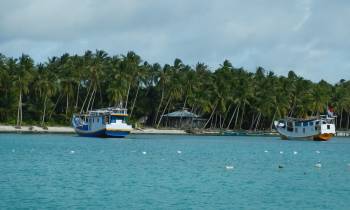
Seaweed farm and local boats, Tanimbar Islands
To Dili, East Timor
22 May 2015, Southeast Indonesia
 Seaweed farm and local boats, Tanimbar Islands |
Dear Friends and Family,
Today began at 5:30, with just a faint glow to the east heralding the coming day. Jon crawled out of bed and started the engines warming up, then started hoisting the mainsail. Sue checked all the hatches and helped Jon with the last of the main before opening the chain locker and starting to raise the anchor. By 5:45 the anchor was up and we were scooting around the reef to get on our course to the SW.
We're headed basically for Dili, on East Timor, but that's still several hundred miles away. We've been anchored off the SW corner of the Kai Archipelago for a few days, waiting to jump off for the north end of the Tanimbar Archipelago, a crossing of some 72nm. We've been watching our weather files, waiting for a day when the SE trades would be a bit more out of the east (with no rain).
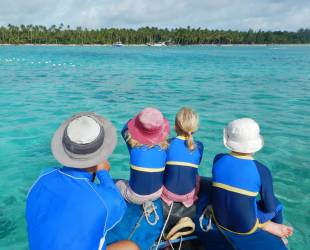 Heading for shore over clear blue water |
A note here on distances: We use nautical miles (nm) which are 1 minute of latitude (so 60 minutes x 360 degrees = 21,600nm around the world). For our land‑based readers, a nautical mile is about 15% longer than a statute mile, or just under 2km (the original definition for a kilometer was the distance from the equator to the pole divided by 10,000, so 40,000km around the world).
Now, 72nm doesn't seem far to those used to cars and highways, but remember that we typically sail at 5‑6 knots, 10% the speed of a car and only 1% the speed of a plane - which explains our early start. Our cruising buddies on Per Ardua left yesterday evening and sailed all night, as they didn't want to risk arriving in the dark.
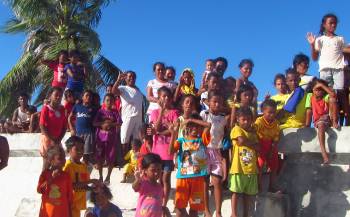 Villagers in the Tanimbars flock to see yachties |
But today was Ocelot's kind of day. The wind was 17‑22 knots from just forward of the beam, one of our fastest points of sail. With our full working sails up, Ocelot scooted along happily at 8‑10 knots(!) for most of the day. Clouds of startled flying fish scattered in front of her, flying inches above the waves, sometimes for hundreds of feet. The tropical blue sky above sported dozens of small puffy clouds drifting NW on business of their own. It was a glorious sail!
Unfortunately, Per Ardua radioed us to say that the harbor‑master where they'd anchored was corrupt, and was trying to extort money from them, a sadly common practice in some ports. So we bypassed that anchorage and their cute little town and anchored off the southern end of Pulau Molu. As usual, a boatload of village men (and a child) came out to visit, but they didn't speak any English, and not much Bahasa Indonesia (which is often a 2nd or 3rd language for them). But we invited them on board and they looked around for a few minutes before heading back to their village with big smiles on. Per Ardua joined us as soon as they could escape the clutches of the evil harbor‑master.
We're now anchored at the south end of the northernmost island of the Tanimbar island group.
Fair Winds and Calm Seas -- Jon and Sue
2 June 2015, Tanimbar Archipelago, East Indonesia
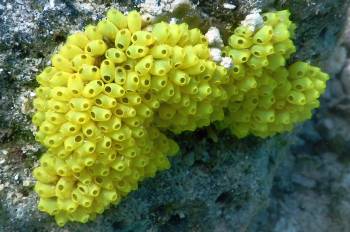 A colony of yellow tunicates on Tanimbar reef. |
Dear Friends and Family,
For several months the winds have been blowing from the west, so we always sought anchorages that were sheltered from the west. This meant that we couldn't usually see the sun actually setting into the ocean. But now that we're into the SE trade winds, we look for anchorages that are protected from the SE. These anchorages are often open to the west, letting us see the sunsets.
We've had 4 "Green Flash" sunsets in the last week, our first for over a year (and the first ever for our cruising buddies
on Per Ardua, who left NZ over 2 years ago). A Green Flash sunset is when the last little bit of the sun, setting into a
clear ocean horizon, turns an aqua‑marine green. Really! And it's not an "anti‑orange" from staring at the setting sun
too long. It's an actual, photographable phenomenon. (Having said that, it's also true that more green flash sunsets
have been seen after a rum or 2, but that's another story...![]() )
)
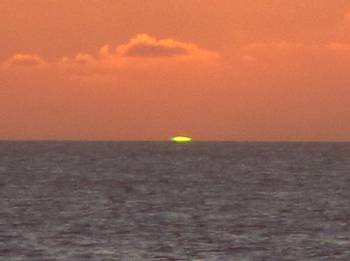 Captured! A real Green Flash sunset! |
In the tropics, the green flash lasts less than half a second. But the phenomenon is also known at higher latitudes, and there the flash can last up to 2 seconds because the earth is spinning slower at higher latitudes. But the sun has to set into a razor sharp ocean horizon, with no clouds or haze, and that's rare at higher latitudes, where clouds often obscure much of the horizon.
For those interested in the theory (and Wikipedia probably does a better job than we can) the short‑wavelength blue light from the sun is scattered by the atmosphere (which is why the sky is blue). The longer red wavelengths are bent by the earth's atmosphere - not a lot, but just enough. As the last little bit of the sun sets, the red is bent right away from the viewer, the blue has already been scattered out, and what's left (what the eye and the camera see) is green, which is in the middle of the visible spectrum.
Does the effect happen on sunRISE? Actually, yes. But few folks are up at that hour. More importantly, when the sun
sets, you know exactly where it's setting. But you rarely know *exactly* where the sun will rise. Remember, we're
looking for a phenomenon that lasts less than half a second. You have to be looking at exactly the right place at
exactly the right time. We typically see 2‑3 green flash sunsets a year (this year is doing well!![]() ) but in all our 20+
years of cruising, Jon and Amanda are the only ones to have seen a green‑flash sunrise, while on watch, crossing the
Pacific, over 10 years ago.
) but in all our 20+
years of cruising, Jon and Amanda are the only ones to have seen a green‑flash sunrise, while on watch, crossing the
Pacific, over 10 years ago.
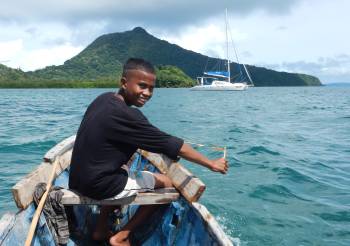 Riding in a local boat with boy with slingshot |
We are still slowly making our way towards Dili on East Timor. It's still about 10 day‑sails away, plus however long we spend exploring. We've been delayed a few days by bad weather, despite this being the beginning of the "dry" season. But it's fun to go gunk-holing from small bay to small bay, snorkeling on what reefs we can find and walking the beaches and talking to the locals, then sharing dinner and good conversation with our cruising buddies.
The crystal ball is unclear after Dili. For the time being we've joined the Indonesian Rally that goes along the north sides of the southern Indonesian islands from Kupang (Timor) to Bali and then up to Singapore. We enjoyed this rally in 2006 and they showed us many more cultural events (dances, tours, meals, etc) than we could have organized on our own. But we've done that before so we may not stay with the rally. We've also talked about going up to explore Tomini Bay, a huge bay in northern Sulawesi which is supposed to have excellent diving, and then up to the Philippines. Or we may go back to Raja Ampat and up to Helen Reef and Palau in the western Pacific, which also have world class diving. So stay tuned...
Fair Winds and Calm Seas -- Jon and Sue
28 July 2015, Dili, Timor-Leste
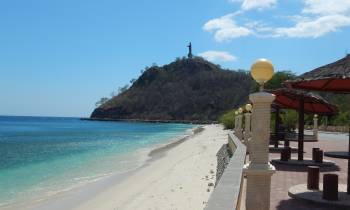 Christ statue over headland, Dili, East Timor |
Dear Friends and Family,
We last wrote as we were making our way from Indonesia to the young country of Timor‑Leste (East Timor). We have now enjoyed over 5 weeks in this strangely European/Asian country, where a mixture of languages keeps one alert: A greeting in Portuguese may be responded to in Indonesian, Tetum or English. A Christ statue with arms outstretched stands over the large natural harbor, and a beautiful promenade with parks and free WiFi borders the anchorage. The war and independence struggles seem far behind, and Dili is a bustling Asian town with blaring car horns, scooters and mini‑buses that transport one from the sea side to the museums and mall for 25 cents.
Our landfall in Timor Leste, however, was not very peaceful. About 100nm east of Dili, as we closed with the rugged mountainous coast, Ocelot suddenly lost both the wind and both engines. In addition, the dad on the yacht Per Ardua (a Kiwi family with 3 small kids who we've been sailing with for months) had a severe leg infection and fever and needed to rest.
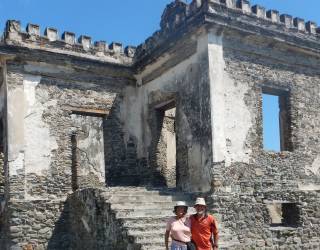 Visiting Portuguese prison ruins near Dili |
Jon got one engine going (it was the engine water pump fan belt that had shredded, and we had spares) and we were able to find a small patch of sand off a village of coconut palms and thatch huts. At dusk we were hailed by men in uniforms from the beach and soon they were boarding Ocelot from a commandeered local outrigger. Jon actually convinced the military and policemen to remove their big boots before climbing aboard, but the M16s came up with them.
Apparently we had anchored in a military zone. The men were friendly but strict: we were not to move the boats until they got the okay from their superiors in Dili. That's the first time in 20 years of cruising we've been under military detainment!
A day and a half later (with the help of US and NZ embassies) we had permission to day‑sail the coast as a concession to Peter's illness and our inability to make long distances against the current in the light winds. As a result we saw lots of Timor‑Leste that few sailors see. The mountains rose craggy and lush above the dry coastal hills. Small villages of thatched huts dotted the landscape. We found very tenuous anchorages right up against the coast on small shelves of sand or mud. The coast is too deep to anchor until it's almost too shallow to anchor! At river mouths we saw trickles of last year's wet season meeting the sea, and there were often fishermen standing in the shallows casting nets. Some herded water buffalo.
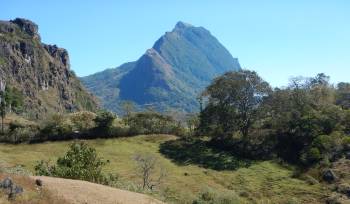 Timor Leste's interior is wild and mountainous |
And offshore, twice, we saw the jagged spines and lumpy heads of large saltwater crocodiles patrolling off the beach.
The creation myth of Timor‑Leste talks of a young boy who saved the life of a crocodile. They became friends and traveled the world together. When the croc was old he turned himself into a large mountainous island, Timor, and the boy's descendants are today's inhabitants of Timor‑Leste. Consequently, crocodiles are revered and not hunted. A lingering belief that only bad people are attacked inhibits the Timorese from reporting croc attacks.
Need we say we did not snorkel or dive on our anchors as we ventured along the coast?
In Dili we made friends with many embassy workers from New Zealand and Australia (the kids on Per Ardua are great door‑openers) and we joined 3 other families on a 3‑day adventure into the interior of Timor‑Leste. We rented a 7‑seater Land Cruiser and went in convoy on some of the worst roads we've ever driven! We drove the coastal road southwest towards the Indonesian border, stopping at the ruins of an old Dutch fort from the 1500's. Then we turned inland into the mountains where we found a "pousada" for the night. We explored the local market, lounged in a sulphur‑y hot springs, slept in the cool of a coffee plantation and hiked to the country's highest waterfall. In all, we covered only 60 miles (100km) per day, but had a great adventure.
For those of you with Facebook accounts, we've posted a photo album of our time in Timor‑Leste on Ocelot's FB page.
Next challenge: fixing our engine cooling systems and finalizing our paperwork and visas for our return to Indonesia.
May your reptiles all be friendly and your winds fair -- Sue and Jon
Indonesia Letters:
Related Pages:
Indian Ocean:
Top Level: Home | Destinations | Cruising Info | Underwater | Boat Guests | Ocelot | Sue | Jon | Amanda | Chris | Site Map | Make a Comment
|
If our information is useful, you can help by making a donation |
Copyright © 2000‑ Contact: Jon and Sue Hacking -- HackingFamily.com, svOcelot.com. All rights reserved.